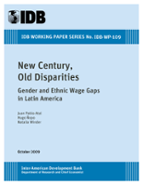New Century, Old Disparities: Gender and Ethnic Wage Gaps in Latin America
Date
Oct 2009
This paper surveys gender and ethnic wage gaps in 18 Latin American countries, decomposing differences using matching comparisons as a non-parametric alternative to the Blinder-Oaxaca (BO) decomposition. It is found that men earn 9-27 percent more than women, with high cross-country heterogeneity. The unexplained pay gap is higher among older, informal and self-employed workers and those in small firms. Ethnic wage differences are greater than gender differences, and educational attainment differentials play an important role in explaining the gap. Higher ethnic wage gaps are found among males, singleincome generators of households and full-time workers, and in rural areas. An important share of the ethnic wage gap is due to the scarcity of minorities in highpaid positions.



